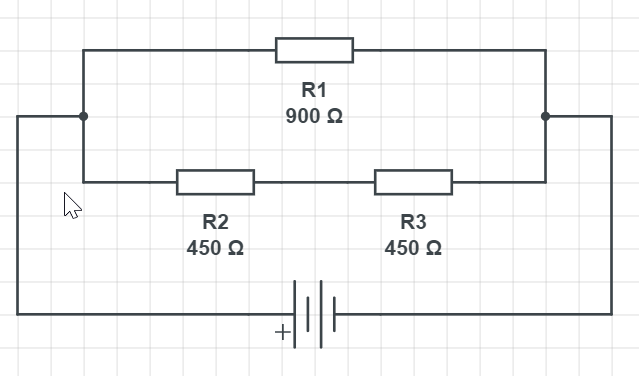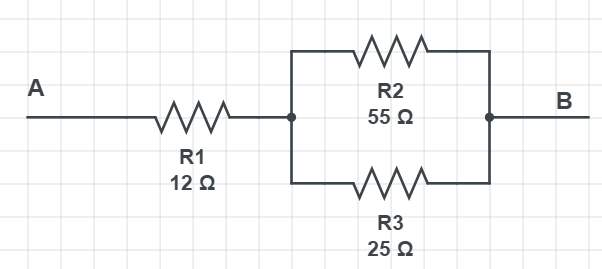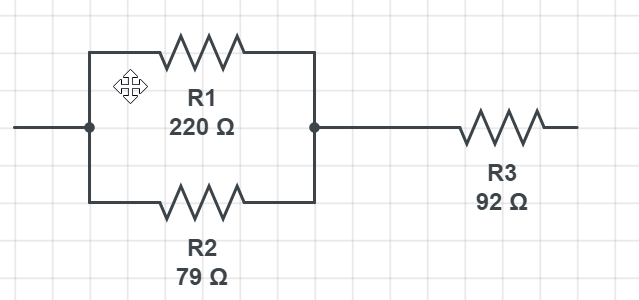
All Solutions
Page 763: Practice Problems

As the same amount of current is going through the lower two resistors and less through the upper one, we know that the total current is going to decrease.
To calculate the current we can follow the calculation from the Example:
$$
frac{1}{R_{mathrm{eq}}}=frac{1}{R_1}+frac{1}{2 R_{2,3}}
$$
Putting in the numbers we have:
$$
frac{1}{R_{mathrm{eq}}}=frac{1}{900 mathrm{Omega}}+frac{1}{2 cdot 450 mathrm{Omega}}
$$
which gives:
$$
frac{1}{R_{mathrm{eq}}}=frac{1}{0.002222 mathrm{Omega}}
$$
we have the result of:
$$
{R_{mathrm{eq}}}=450.45 mathrm{Omega}
$$
To get the current we have:
$$
I=frac{varepsilon}{R_{text {eq }}} = frac{12 mathrm{~V}}{450.45 Omega} = boxed{color{#c34632}0.027 mathrm{A}}
$$
(a) mathrm{Decreases}
$$
$$
(b) I= 0.027 mathrm{A}
$$

$$
R_{eq}=R_1 + R_{2,3}
$$
where $R_{2,3}$ is:
$$
frac{1}{R_{2,3}}= frac{1}{R_2} + frac{1}{R_3}
$$
putting in the numbers for $R_{2,3}$ gives:
$$
frac{1}{R_{2,3}}= frac{1}{55 mathrm{Omega}} + frac{1}{25 mathrm{Omega}}
$$
that gives:
$$
frac{1}{R_{2,3}}= 0.0581 mathrm{Omega} Rightarrow R_{2,3}= 17.19 mathrm{Omega}
$$
Now back to starting equation:
$$
R_{eq}=R_1 + R_{2,3} =12 mathrm{Omega} + 17.19 mathrm{Omega} = boxed{color{#c34632}29.19 mathrm{Omega}}
$$
R_{eq} = 29.19 mathrm{Omega}
$$
The first things to conclude is that we need to definitely connect $220 Omega$ in parallel with any of these, because connecting into the parallel will give $textbf{less resistance}$ then they are having together:
$$
frac{1}{R_{mathrm{eq}}}=frac{1}{R_{1}}+frac{1}{R_{2}}
$$
Putting in the numbers for first two resistors, we have:
$$
frac{1}{R_{mathrm{eq}}}=frac{1}{220 Omega}+frac{1}{79 Omega}= frac{1}{0.0172 Omega}
$$
where the result is:
$$
R_{eq} = 58.13 mathrm{Omega}
$$
Now getting back to start we can add the third one to this:
$$
R_{tot} = 58.13 mathrm{Omega} + 92 mathrm{Omega}
$$
which gives:
$$
R_{tot} = 150.13 mathrm{Omega}
$$
The correct scheme can be found in the picture below:

Haven't found what you were looking for?
Search for samples, answers to your questions and flashcards

